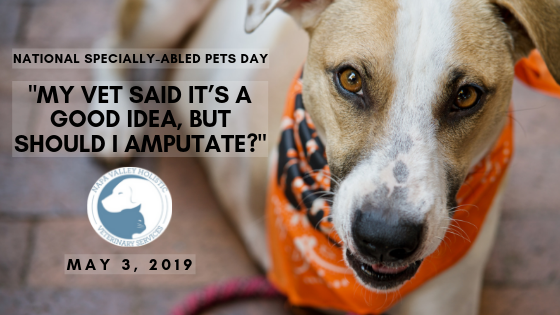By: Kimberly Schmidt, DVM, CVA, CVCH, CVFT
(Veterinarian, animal acupuncturist, herbalist and food therapist)
When your dog or cat becomes seriously ill, your veterinarian will always discuss the best treatment options available for them. Arguably one of the most difficult conversations is regarding limb amputation.
National Specially-abled Pets Day approaches on May 3rd, 2019. This day is set aside to educate the public about caring for disabled pets. It is also a day to honor the amazing dogs and cats who have braved challenges such as amputation. Although it is a difficult topic, learning about the realities of limb amputation can provide a roadmap for navigating this situation when it presents itself. I hope this blog helps you to make the best decision for your pet and your family
The “why”?
There are several reasons your veterinarian may recommend amputation for your pet. For example, Dr. Kim’s own dog was hit by a car when he was 6 months old. His elbow was badly broken and surgical repair was impossible. To eliminate his pain and provide him the best quality of life, amputation was recommended. Following the surgery he was adopted by Dr. Kim and has done extremely well! He is now 8 years old and still runs around her yard and plays. She often forgets he has 3 legs.
Limb amputation may also be recommended as a treatment for cancer. Cancer is often an aggressive disease and can be quite painful, even with the best pain medications on board.
Why would limb amputation be recommended for your pet’s cancer?
To completely remove a tumor, in hopes of a cure.
To completely relieve pain and discomfort caused by the tumor.
The tough part.
There is no doubt that amputation can remove the source of pain, and can often prolong your pet’s ability to survive. However in many cases the decision is not a simple one. Many pet parents worry about loss of mobility, a changed appearance and also the cost of surgery. We often think about how we would react if we were to lose an arm or a leg. However we must remember that dogs and cats are not people. After the initial recovery from surgery, companion animals generally do extremely well with amputation! They can adapt very quickly and learn to navigate their surroundings with ease. Many animals have a dramatic improvement in mood and appetite because they are no longer in pain. We must remember that above all else the goal for our animal friends should be the best quality of life with the least discomfort. Even still, amputation is a very personal decision. Your decision should always be respected by your family, your friends and your veterinarian.
Survive and thrive.
The ability of dogs and cats to compensate following amputation is amazing. In a survey of American pet owners following the amputation of their pet’s leg, nearly three-quarters saw no change in their pet’s recreational activities and indicated the dog's recovery and adaptation were better than expected.1 Dogs and cats are a lot more resourceful and rebound a lot faster than most people realize.
One look at these videos of Max happily playing with his owner, and Dr. Kim’s dog Beau playing with his flashlight tells the story best.
When we widen our view to what quality of life looks like for our pets, we can see a path forward. To see additional videos and learn more about amputation from the viewpoint of pet families, visit the Tripawds website.















